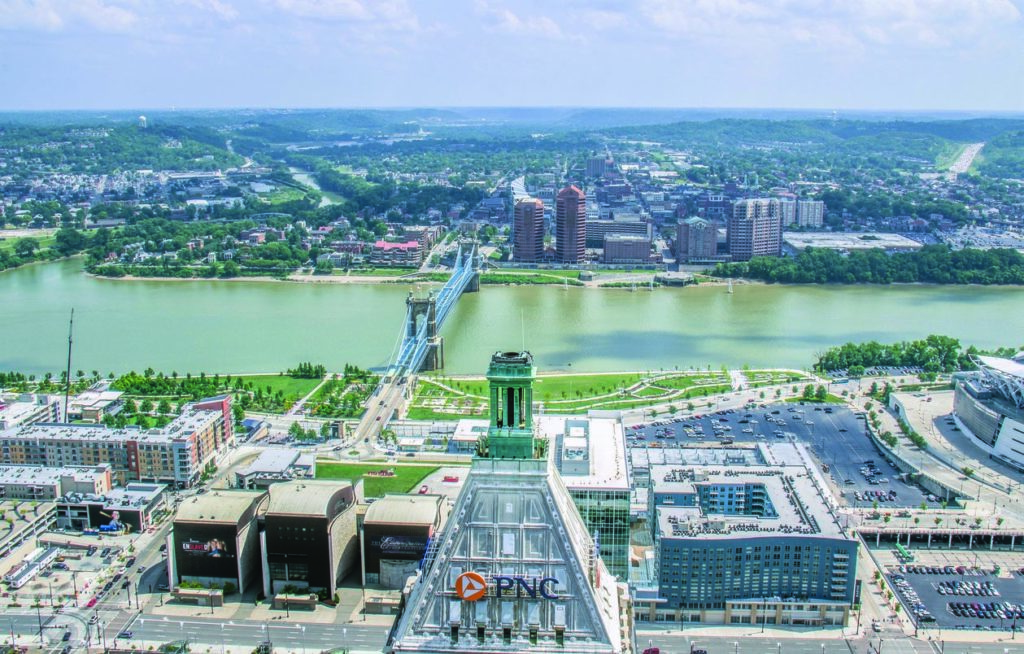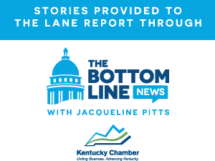 Like virtually every other business in the country that depends on nuts-and-bolts transactions coupled with face-to-face relationships, banks in Northern Kentucky, throughout the state and across the country were forced to make dramatic changes in their operations to keep customers and employees healthy as they attempted to keep pace with rapidly changing state and local regulations as well as guidance from health-care professionals.
Like virtually every other business in the country that depends on nuts-and-bolts transactions coupled with face-to-face relationships, banks in Northern Kentucky, throughout the state and across the country were forced to make dramatic changes in their operations to keep customers and employees healthy as they attempted to keep pace with rapidly changing state and local regulations as well as guidance from health-care professionals.
 While those measures tamped down the number of people who walked through the doors, low mortgage interest rates for home buyers and the federal government’s Payroll Protection Program (PPP) to help small businesses and their employees bolstered bottom lines for some banks in the state.
While those measures tamped down the number of people who walked through the doors, low mortgage interest rates for home buyers and the federal government’s Payroll Protection Program (PPP) to help small businesses and their employees bolstered bottom lines for some banks in the state.
One other huge COVID-impact change: Most bankers interviewed said they were convinced that “stay/work at home” orders accelerated the acceptance of mobile banking for a task that once involved bank foyers, teller lines and pre-printed paper forms in triplicate.
David Wallace, CEO and chairman of Heritage Bank in Burlington, said COVID-19 hastened the acceptance of new technology for customers who might have been reluctant adopters in the past.
“The biggest impact on Heritage Bank is the uptick in customers embracing digital banking capabilities. It validates the investment we made in consumer-facing technology…,” said Wallace.
“People who have become accustomed to the convenience of conducting more of their banking online are going to continue to bank online. We’ve seen online banking registrations and usage grow by leaps and bounds.”
Heritage Bank is the largest bank with a home office in Northern Kentucky and operates 17 offices in the Northern Kentucky counties of Boone, Campbell, Grant, Kenton and Pendleton. Heritage Bank celebrated its 30th anniversary in 2020.
Bill Jones, regional executive for the community east division of U.S. Bank, agreed with Wallace about how technology has changed banking. U.S. Bank is headquartered in Cincinnati and has six offices in Boone County, five in Campbell and eight in Kenton.
“Today, two-thirds of all banking transactions occur on a mobile device (and) geography is no longer a barrier to building and maintaining a customer relationship. We are re-imagining what the ‘future of banking’ looks like by investing in new technology and digital security,” said Jones, whose bank is part of U.S. Bancorp in Minneapolis, the fifth-largest in the country with $547 billion in assets and some 70,000 employees.
“One of the biggest transitions for the banking industry that has emerged has been the need to offer the full range of digital services,” said Louis Fender, WesBanco’s senior vice president and senior banker for southwest Ohio and Northern Kentucky. “WesBanco has long had a robust platform of digital banking services that meets the unique needs of our customers.”
WesBanco, with a home office in Wheeling, W.Va., has nine branches in Northern Kentucky and eight more in metropolitan Cincinnati.
As technology evolved and the pandemic continued, more and more people chose to do their transactional banking – depositing a check, making a mortgage payment – on mobile devices, according to Jason E. Payne, senior vice president and managing director for Republic Bank in Northern Kentucky, where three of its offices are located.
The pandemic forced banks to rely more and more on technology because of risks associated with in-office transactions.
Many customers opted to use “contactless cards” that don’t have to be swiped or inserted, while mobile and online banking continued to grow faster than brick and mortar transactions at Central Bank, said Paul R. Thornsberry, executive vice president and director of lending for the Lexington-based institution. “I think this (the pandemic) may have accelerated that some,” he said.
What is not changing, Republic Bank’s Payne said, are the relationships with customers.
“You still need to have conversations around anything from an automobile loan all the way up to a $10 million commercial loan,” he said.
Competition among banks was keen despite concerns about COVID-19 and the dark clouds it cast over the economy.
The most recent market-share information on deposits for the metro area shows that U.S. Bank holds nearly half of the $162 billion on deposit in the 685 bank branches that are affiliated with 58 institutions in Ohio, Kentucky and a sliver of southeast Indiana.
Cincinnati-based Fifth Third Bank comes in second with nearly $46 billion, which represents a little more than 28% of the deposits in the region, according to FDIC data as of June 30, 2020. Heritage Bank in Burlington ranked ninth with 19 offices and about $1.04 billion on deposit.
By comparison, the Louisville metro area is second largest in the state, with 41 banks that have $34.7 billion in deposits, according to FDIC reports.
Although most bankers rejected the notion that processing applications for the “forgivable” PPP loans was simple, quick and lucrative, a number of bankers acknowledged that handling the loans opened their doors to new customers.
“Some of the larger banks couldn’t respond quickly enough and then (businesses) turned to Republic,” Payne said. “We got a lot of really good clients just because we responded in such a crisis moment. They moved their banking to us, so locally we’ve gained a significant amount of new, really good clients that moved over to us from some of the larger banks in town.”
Payne said Republic invested much time and energy in the PPP loan program that was designed to help businesses retain their employees even if business activity had been snuffed out by the pandemic. Louisville-based Republic Bank is the largest bank with a home office in the commonwealth and ranks sixth statewide in its share of deposits.
“The loans were kind of revenue neutral – almost a neutral offset,” said Payne. “It’s certainly a business model you wouldn’t pursue permanently.”
Central Bank, headquartered in Lexington, helped some cash-strapped borrowers by approving “modifications” to existing loans while it processed about 9% of the PPP applications that were filed by Kentucky businesses.
“We got out front of that (the PPP program) early on so we were prepared for that,” said Thornsberry, whose bank made 2,526 loans for more than $412 million.
Like nearly every bank executive who was interviewed, Thornsberry said processing PPP applications provided a valuable introduction to his bank for many business owners who hadn’t banked there before.
“We did not shut ours (the lending program) down to (existing) customers only. We opened it up to noncustomers as well, so we have benefited with some additional relationships out of that,” he said.
All of the bankers who were interviewed said their banks participated in the PPP loan program that provided loans to businesses that were required to keep people on their payrolls rather than lay them off.
U.S. banks collected billions of dollars in fees that ranged from 1% to 5% for processing applications.
Smaller banks participated less while big banks went all in. Heritage Bank, small by national metrics, made 995 loans for about $108.5 million, Wallace said.
WesBanco processed some 7,200 loans for about $853 million, which included 83% that were less than $150,000 each, Fender said. U.S. Bank, with offices in 26 states, processed more than 108,000 loans for about $7.6 billion, including about 1,900 in Kentucky for more than $126 million, the bank reported.
Civista Bank, headquartered in Sandusky, Ohio, helped more than 2,200 businesses secure over $250 million in PPP loans, allowing the businesses to support more than 36,000 employees, said Mark Sams, regional market executive.
“Many Civista employees crossed department lines and worked late into the night many nights to secure funds for our customers,” he said. “This effort continues as we are actively assisting borrowers submit their PPP Forgiveness Requests to the Small Business Administration.”
Regardless of their size, banks want customers to believe that they’re friendly and welcoming, kind of like the bar in the old “Cheers” sitcom where “everybody knows your name.” They recognize the importance of one-on-one interactions, most bankers said.
“The customer is at the heart of everything we do. While the pace of innovation accelerates, our focus on the customer ensures we provide products and services that are safe, simple and convenient,” U.S. Bank’s Jones said.
The key to remaining successful at maintaining and growing relationships is to continue to provide responsive and exceptional customer support, including financial advice and digital services, WesBanco’s Fender said.
With more than $1 billion in deposits in the region and what sounds like high-tech sophistication, Wallace was optimistic about his bank’s future.
“We look forward to driving a sharper distinction between Heritage Bank and competitors who use technology to reduce head count and personal customer interaction as well as the distinction between Heritage Bank and smaller community banks whose technology has not kept pace. It’s a unique niche – sort of the best of both worlds,” he said.




















Add Comment